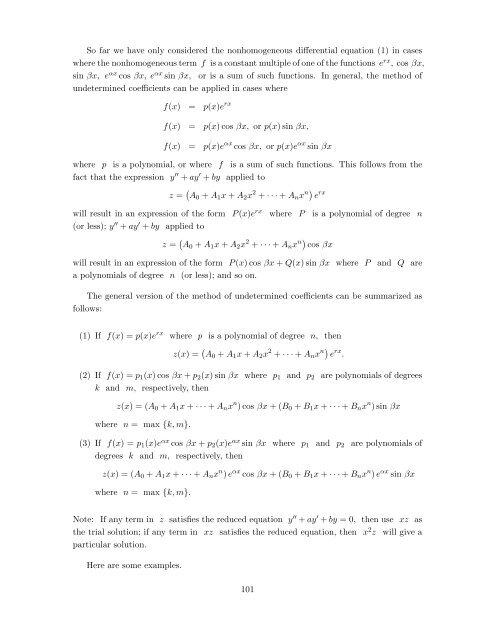Second Order Linear Differential Equations
Second Order Linear Differential Equations
Second Order Linear Differential Equations
You also want an ePaper? Increase the reach of your titles
YUMPU automatically turns print PDFs into web optimized ePapers that Google loves.
So far we have only considered the nonhomogeneous differential equation (1) in cases<br />
where the nonhomogeneous term f is a constant multiple of one of the functions e rx , cos βx,<br />
sin βx, e αx cos βx, e αx sin βx, or is a sum of such functions. In general, the method of<br />
undetermined coefficients can be applied in cases where<br />
f(x) = p(x)e rx<br />
f(x) = p(x) cos βx, or p(x) sin βx,<br />
f(x) = p(x)e αx cos βx, or p(x)e αx sin βx<br />
where p is a polynomial, or where f is a sum of such functions. This follows from the<br />
fact that the expression y ′′ + ay ′ + by applied to<br />
z = A0 + A1x + A2x 2 + ···+ Anx n e rx<br />
will result in an expression of the form P (x)e rx where P is a polynomial of degree n<br />
(or less); y ′′ + ay ′ + by applied to<br />
z = A0 + A1x + A2x 2 + ···+ Anx n cos βx<br />
will result in an expression of the form P (x) cos βx + Q(x) sin βx where P and Q are<br />
a polynomials of degree n (or less); and so on.<br />
The general version of the method of undetermined coefficients can be summarized as<br />
follows:<br />
(1) If f(x) =p(x)e rx where p is a polynomial of degree n, then<br />
z(x) = A0 + A1x + A2x 2 + ···+ Anx n e rx .<br />
(2) If f(x) =p1(x) cos βx + p2(x) sin βx where p1 and p2 are polynomials of degrees<br />
k and m, respectively, then<br />
z(x) =(A0 + A1x + ···+ Anx n ) cos βx +(B0 + B1x + ···+ Bnx n ) sin βx<br />
where n = max {k, m}.<br />
(3) If f(x) =p1(x)e αx cos βx + p2(x)e αx sin βx where p1 and p2 are polynomials of<br />
degrees k and m, respectively, then<br />
z(x) =(A0 + A1x + ···+ Anx n ) e αx cos βx +(B0 + B1x + ···+ Bnx n ) e αx sin βx<br />
where n = max {k, m}.<br />
Note: If any term in z satisfies the reduced equation y ′′ + ay ′ + by = 0, then use xz as<br />
the trial solution; if any term in xz satisfies the reduced equation, then x 2 z will give a<br />
particular solution.<br />
Here are some examples.<br />
101

















